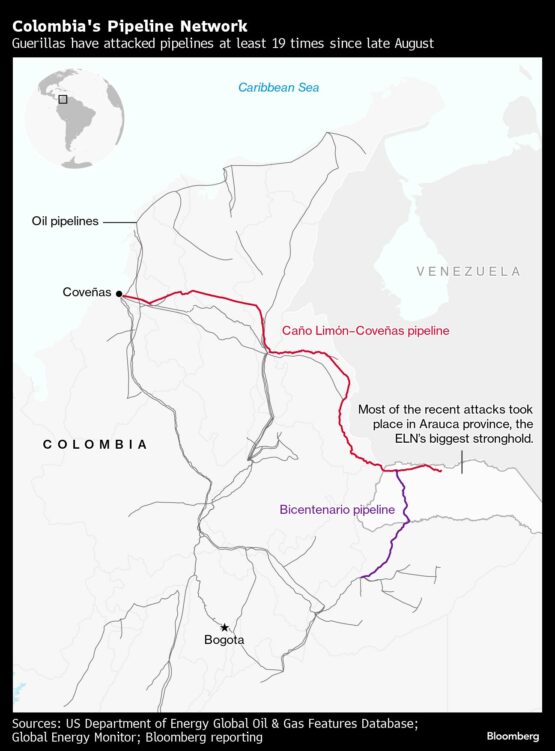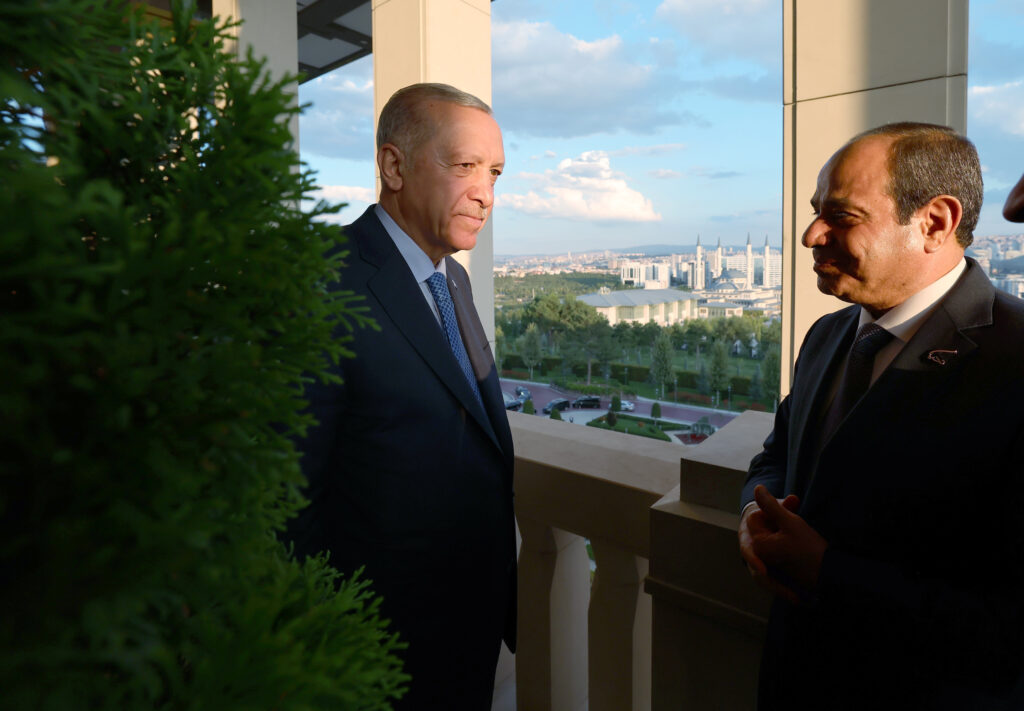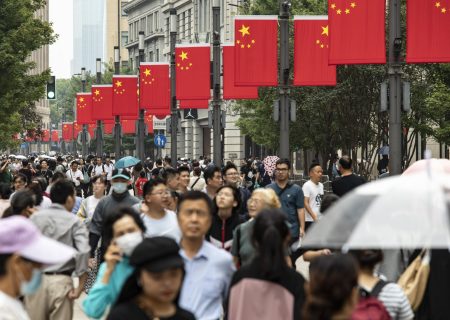Colombian rebels have reopened their war on the oil industry with a wave of pipeline attacks that sent crude spilling into rivers and clouds of black smoke billowing into the sky.
The world’s oldest guerrilla force, known as the National Liberation Army, or ELN, is reactivating its six-decade campaign of sabotage after peace talks with the government broke down, raising the stakes for President Gustavo Petro by hitting the sector that produces a third of the nation’s exports. The leftist group also renewed hostilities with government security forces, opening fire on police bases and killing five soldiers in ambushes.
The violence — including at least 19 pipeline attacks since late August — is adding to Petro’s woes as security deteriorates across swathes of the countryside while he struggles to rein in discontent in the cities. Last week, officials were forced to mostly concede to demands from striking truckers whose paralysing blockades shut schools and public transit.
It’s also another headwind for Colombia’s struggling oil industry, along with falling reserves, heavy taxes and hostility from Petro, an environmentalist who wants to phase out fossil fuels and has refused to grant new exploration licenses.
Producers had enjoyed more than a year of pumping crude relatively unhindered while guerrilla leaders met negotiators, seeking a deal that would see the group lay down its arms in exchange for legal and constitutional reforms to provide more support for the poorest citizens. The latest attacks show that the ELN still has the oil industry in its sights and is nowhere near to ending its war.
Meanwhile, the group’s sophisticated extortion network continues to target businesses operating in its territory.
The rebels have long viewed the oil industry as a military target as well as a cash cow. The group’s antagonism comes from its belief that Colombia should have sovereignty over its natural resources, rather than selling rights to private companies, according to Carlos Velandia, a former senior commander in the group who left in 2004.
“The ELN believes that the oil companies have been able to get contracts that are very advantageous for themselves, but bad for the country,” said Velandia, who now monitors the conflict as the head of the Peace Observatory at Colombia’s National University in Bogota.
While supply disruptions from Colombia aren’t big enough to roil global markets, the conflict is another example of the violence endemic in crude-producing regions throughout the world — from Houthi rebels in Yemen who target tankers in the Red Sea to pipeline attacks in the oil-rich Niger Delta region.
Colombia’s state-controlled oil company, Ecopetrol SA, which owns the pipelines, said 4 September that the attacks, along with the truckers’ strike and protests at a natural gas plant, have seriously affected its operations. The company hasn’t provided an estimate of how much production has been curtailed since the attacks restarted.
As of 6 September, the Caño Limon-Coveñas pipeline was still damaged, while the Bicentenario pipeline was functioning again. After placing explosives, the ELN often deploys mines and snipers to make it harder for the army and repair teams to enter the area.
Most of the recent attacks took place in Arauca province, the ELN’s biggest stronghold. The two pipelines connect Arauca, which produces about 58 000 barrels of crude per day — or 7% of the nation’s output — with refineries and a Caribbean port. Canada’s Parex Resources Inc. and SierraCol Energy, a subsidiary of the Carlyle Group, operate in the region.
Petro took office in 2022, pledging to seek “total peace” through talks with the guerrillas and drug cartels whose militias dominate much of the countryside. But so far the various negotiations have had limited success.
Negotiations with the ELN broke down in May over issues including the government’s refusal to remove the rebels from a list of organized crime organizations. But the group stuck to its ceasefire until this expired in August as efforts were made to get the talks back on track.
Petro is himself a former leftist guerrilla. But the ELN, which was inspired by the communist revolution in Cuba, says Colombia’s “oligarchy” is blocking his attempts to reform the nation’s conservative economic model.
Extortion network
Electricity company Grupo Energia Bogota SA, the fourth-most valuable business on Colombia’s stock exchange, recently ran into the ELN’s extortion network when it studied building a power line to connect Arauca with the national grid.
Shakedowns from the ELN have made Arauca among the most expensive places in Colombia to do business, according to Juan Ricardo Ortega, the company’s chief executive officer.
“When we looked at how much it would cost to get people to build the towers, to transport the materials, everybody began to charge 45% more” than in peaceful regions of the country, he said.
The ELN sets fire to trucks and buses operating in its territory without its permission. Even if big companies don’t make payments to the group, their subcontractors have little choice, pushing up the price of everything from transport to security services, Ortega said.
Paying money to an illegal armed group could bring US charges for financing terrorism. For businesses operating in regions dominated by the guerrillas, there are many ways of staying off the radar of the US justice system, but there is no way to skirt the ELN’s attention, according to Velandia.
“It’s not possible to avoid doing deals with them, but it doesn’t necessarily have to involve handing over cash,” Velandia said.
One favoured method is for social organizations that are sympathetic to some of the ELN’s objectives to organize strikes to pressure a company into paying for projects such as paving a road or building a health clinic.
The guerrillas then get the credit for bringing investment to areas abandoned by the government, while also taking a cut for themselves.
“For the guerrillas to tolerate the presence of a multinational, they tell them to build a road or bridges or schools,” Velandia said. “That’s a way of camouflaging payments as social investment, rather than giving money to an organization that’s listed as a terrorist group.”
Companies find that it is cheaper to pay up and incur the risk of US sanctions than to refuse the guerrillas’ demands, which effectively means not being able to operate at all, according to Rodrigo Villamizar, a former Colombian energy minister who now heads Electra, a Bogota-based think tank focused on the power sector.
Cocaine ban
In Arauca, the ELN’s hold over local politics is such that five former governors have been accused by prosecutors of having ties with the group.
The region, which borders Venezuela, is unusual in that oil, rather than illegal drug production, has long been a main driver of the violence. Since 2019, it has been one of the few Colombian conflict zones that doesn’t have any coca, the raw material for making cocaine, according to data compiled by the Ministry of Justice.
That’s because the Domingo Lain front, an elite group within the ELN that controls much of Arauca, grew so rich from shaking down businesses and government contractors that it decided it no longer wanted or needed cocaine production in its territory and banned it across the entire province of 24 000 square kilometres.
Follow Moneyweb’s in-depth finance and business news on WhatsApp here.























COMMENTS 0
You must be signed in to comment.
SIGN IN SUBSCRIBE
or create a free account.
Free users can leave 4 comments per month.
Subscribers can leave unlimited comments via our website and app.